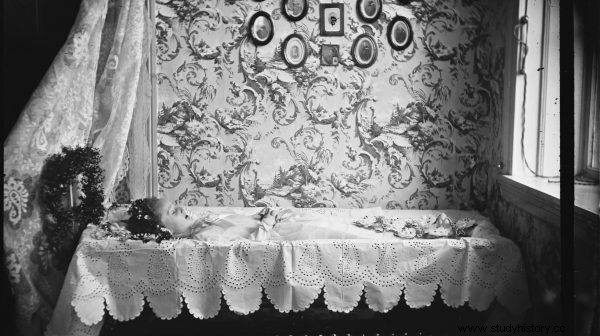A meal for the redemption of wines. A piece of bread eaten over the body to give the soul eternal life. How it's possible? All thanks to the sin eaters.
They worked mainly in Wales. Among the few preserved information about them, some are intertwined with local legends. What is for sure? It wasn't a nice job. Contrary. For religious people this job was one of the worst jobs ever. On the other hand, it protected from a very real fear at the time:sudden and unexpected death, with no chance of absolution.
What do death and food have in common?
It turns out quite a lot. And although it may sound quite macabre at first, the custom of organizing a funeral after a funeral is nothing strange to us . Eating rituals during or immediately after funeral rites is quite a popular idea. Regardless of religion, social class and latitude.

The custom of organizing a funeral after a funeral is nothing strange to us
Sometimes it was purely practical. Throughout medieval Europe, it happened that the rich social classes, in particular nobles, provided meals to the poor on the day of the funeral to get them to pray for the soul of a deceased family member. And from here it is close to Welsh beliefs. From the 17th to the beginning of the 20th century, there are records of the so-called sin eaters . The rite was cultivated especially in the Shropshire and Monmouthshire areas.
Responsibilities of the sin eater
The role of the eaters was not complicated. They appeared when someone died suddenly or when, for some other reason, the last confession was impossible. The family prepared a modest meal and sent for someone to take the blame their loved one.
The most common - a piece of bread lying on the chest and some beer. Sometimes groats and wine also appear in the descriptions. The sin-eater ate it from the body of the person whose soul he was to cleanse while saying a short prayer. Sometimes, instead of putting a meal on a corpse, someone in the family would simply serve it over the coffin. What was the purpose of such a rite? According to Welsh belief, food absorbed unconfessed sins . In short, it was about a victim. The eater sacrificed his own soul to guarantee someone else's salvation. Some researchers, in their search for possible sources of this custom, go as far as ... the Jewish scapegoat.

The family prepared a modest meal and sent for someone who would take the blame of their loved one upon himself.
The rite was completed with a short prayer over the body of the deceased. According to the preserved text, it can be translated as:“I am giving you rest and rest, dear man. Do not go down the streets and our meadows. For your peace of mind, I pawn my own soul. Amen". This suggests that the role of the eaters was not only to cleanse the wines. They had one more, very important task. They made sure that the dead did not haunt the living.
Desired job? Not at all
As you can easily guess, this is not a job for the social elite. On the contrary. The eaters were mostly marginalized. Earnings almost none, at most a few small coins or an extra meal for later. The best-off did not need such a service. Their peace of mind was guaranteed by generous donations to the Church. No wonder that "decent" people did not bother eating sins . This job was mostly occupied by the homeless, beggars and alcoholics. All those who were willing to sacrifice a chance for salvation in exchange for a meal.
Perhaps they could at least count on the gratitude of the deceased's family, whom they guaranteed eternal life? While it was a valuable favor to keep the soul from returning to earth, sin-eating workers were not liked by society . It was generally assumed that they were better avoided. One of the superstitions was that looking into their eyes would bring disaster.
Researchers in the profession assume that eaters lived apart from the rest of society , in the suburban area. Such an opinion is shared by Bernard Puckle. After finishing their service, they had to leave the house to which they had been brought as soon as possible. Otherwise, they exposed themselves to sticks and stones. All the utensils they touched were destroyed immediately.
Death of the profession, life of custom
Usually, eating sins was a rite performed once, by the poorest, tempted by a free meal. However, in some places, such as in Monmouthshire, Wales, there were professionals. They visited all local funerals. And although these people were commonly known and needed, they aroused the greatest fear. Why? The more sins assumed, the more burdened the soul was.

Usually, the eating of sins was a one-time rite.
The last sin eater, Richard Munslow, died in 1906 . Shropshire resident… eminently did not fit the description earlier. First of all - he was not a social outcast. Contrary. He was a well-to-do farmer. He was respected by his neighbors. He certainly did not take up this job because of poverty. Why? It is not entirely clear. Most often it is assumed that grief over the death of one's own children . He began to cultivate this rite during the funerals of his relatives. And it stays that way…
In 2010, Munslow's tomb was restored by the local community, and its technical condition was even praised by the local vicar, Norman Morris. However, the clergyman remarked:"I do not want to restore the ritual that came with it." This does not mean that the custom is completely forgotten. As the "Encyclopedia Britannica" writes under the concept of "sin eaters": the rite echoes with funeral cakes and cakes prepared in some parts of England. Just like Dutch and Bavarian cakes, as well as Balkan bread eaten by loved ones during the last goodbye.
